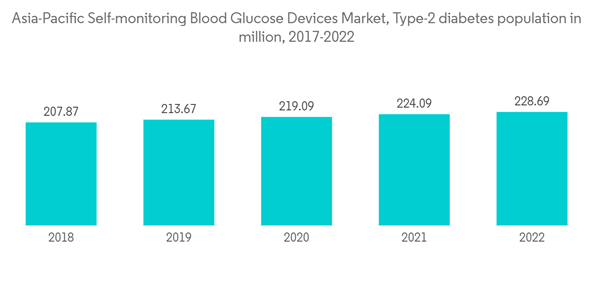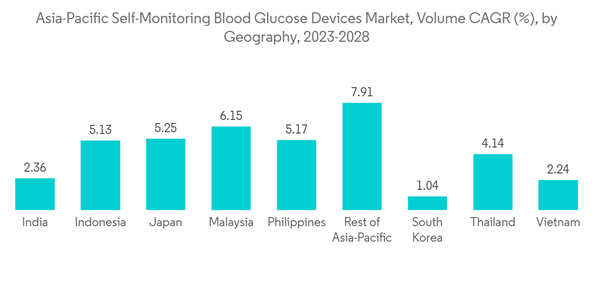The COVID-19 pandemic positively impacted the Asia-Pacific self-monitoring blood glucose market growth. Patients with diabetes, infected with COVID-19 may experience elevated blood glucose, abnormal glucose variability, and diabetic complications. The prevalence of diabetes in people with COVID-19 caused a significant increase in severity and mortality of COVID-19 in people with either type 1 (T1DM) or type 2 diabetes mellitus (T2DM), especially in association with poor glycemic control. While new-onset hyperglycemia and new-onset diabetes (both T1DM and T2DM) have been increasingly recognized in the context of COVID-19 and have been associated with worse outcomes. To avoid aggravation, a patient's blood glucose should be monitored regularly, which has underlined the importance of self-monitoring blood glucose devices. Pandemic emergency has created a rise in remote care from both patients and providers and removed many long-standing regulatory barriers. Thus, the COVID-19 outbreak increased the self-monitoring blood glucose market's growth.
According to International Diabetes Federation (IDF), 90 million adults (20-79) are living with diabetes in the IDF South-East Asia (SEA) Region in 2021. This figure is estimated to increase to 113 million by 2030 and 152 million by 2045 and 206 million adults (20-79) are living with diabetes in the IDF Western Pacific Region in 2021 which is estimated to increase to 238 million by 2030 and 260 million by 2045. The main diagnosis for diabetes patients is imbalances in blood glucose levels, which are not in compliance with the standard blood glucose levels. The general lab diagnostic tests can only help to diagnose the disease by physicians. Patients with more fluctuations in glucose levels need to get it checked every day. Patients administering insulin need to check their blood glucose levels frequently, adjust the doses of insulin, or change the medication, if necessary, which is only possible with the use of self-monitoring blood glucose devices.
Therefore, owing to the aforementioned factors the studied market is anticipated to witness growth over the analysis period.
Asia-Pacific Self-Monitoring Blood Glucose Devices Market Trends
Test strips segment holds the highest market share in the current year
The test strips segment holds the highest market share of about 73% in the Asia-Pacific self-monitoring blood glucose market in the current year.Blood glucose test strips are small, disposable strips and are a key component of blood glucose testing. When blood is placed on the test strip, it reacts with a chemical called glucose oxidase, producing gluconic acid from the glucose in the blood. At the other end of the test strip, the meter transfers a current to the strip. The test strip has electric terminals, which allow the meter to measure the current between the terminals. The current between the terminals changes depending on the level of gluconic acid that has been produced. The blood glucose meter then uses an algorithm to work out the blood glucose level based on the difference in current.
The growth in market share of test strips is expected to be higher than that of glucose meters because of the difference in use-case frequency. The glucometer is a one-time purchase; test strips, on the other hand, are a continuous investment as a test strip needs to be disposed of after one use, causing a recurrent cost impact. While an average glucose meter lasts anywhere between six months and three years, presenting a one-time cost during the same time frame,
Diabetes mellitus has been of wide concern with its high prevalence, resulting in increased financial burdens for clinical systems, individuals, and governments. The market players are adopting various strategies such as collaborations, partnerships, mergers, acquisitions, and expansions to increase market share. For instance, in August 2021, FIND announced that agreements were signed with i-SENS, Inc. (Seoul, South Korea) and SD BIOSENSOR, Inc. (Suwon-si, South Korea) to increase low- and middle-income countries' access to blood glucose test strips by improving affordability.
Thus, owing to the increased prevalence of diabetes and the above-mentioned factors, the market is expected to grow over the forecast period.
China holds the highest market share in the Asia-Pacific Self-monitoring Blood Glucose Devices Market in the current year
China holds the highest market share in the Asia-Pacific self-monitoring blood glucose market in the current year and is expected to register a CAGR of about 5.7% over the forecast period.As per the IDF 2021 report, an estimated 141 million adults were living with diabetes in China. The country had the highest number of deaths from diabetes in the Western Pacific region, at approximately 1.4 million, and the second-highest diabetes-related health expenditure in the world, at 165.3 billion USD. More than half of adults currently living with diabetes in China are undiagnosed. About 90% of people with diabetes have type-2 diabetes. The rise in the number of people with type-2 diabetes is driven by a complex interplay of socio-economic, demographic, environmental, and genetic factors. Key contributors include urbanization, an aging population, decreasing levels of physical activity, and increased levels of overweight and obesity.
Evidence suggests that type-2 diabetes can often be prevented, while early diagnosis and access to appropriate care for all types of diabetes can avoid or delay complications for people living with the condition. When diabetes is undetected or inadequately treated, people with diabetes are at risk of serious and life-threatening complications, such as heart attack, stroke, kidney failure, blindness, and lower-limb amputation. These result in reduced quality of life and higher healthcare costs. China has significantly improved the detection and management of diabetes with its pilot projects in national demonstration areas and its attempts to improve health system integration. These initiatives demonstrate a willingness to confront the rise of diabetes with strategies based on health promotion, disease detection, and management of the multiple conditions and complications associated with the disease.
Therefore, owing to the aforesaid factors, the growth of the studied market is anticipated in the Asia-Pacific region.
Asia-Pacific Self-Monitoring Blood Glucose Devices Industry Overview
The Asia-Pacific self-monitoring blood glucose devices market is fragmented with a few major manufacturers like Abbott, LifeScan, Roche, and Ascensia etc. gaining presence in major countries of the Asia-Pacific market, while the remaining market comprises other local or region-specific manufacturers.Additional Benefits:
- The market estimate (ME) sheet in Excel format
- 3 months of analyst support
This product will be delivered within 2 business days.
Table of Contents
Companies Mentioned (Partial List)
A selection of companies mentioned in this report includes, but is not limited to:
- Abbott Diabetes Care
- Roche Diabetes Care
- LifeScan
- Arkray
- Ascensia Diabetes Care
- Bionime Corporation
- Acon
- Sinocare
- Medisana
- Dr. Trust
- I-Sens
- Morpen Laboratories
- Rossmax International
Methodology

LOADING...










